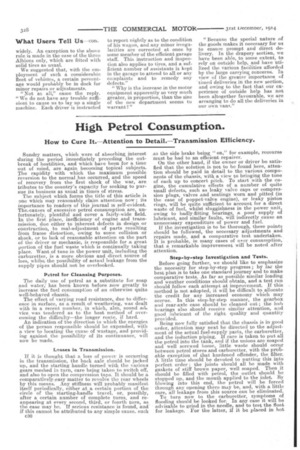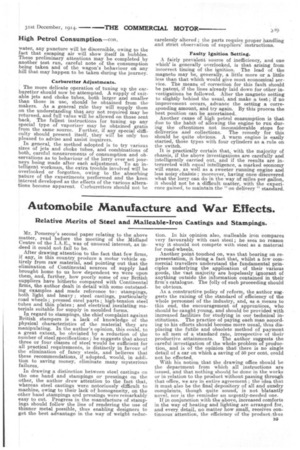High Petrol Consumption.
Page 12

Page 13

If you've noticed an error in this article please click here to report it so we can fix it.
How to Cure It. Attention to Detail.—Transmission Efficiency.
Sundry matters, which were of absorbing, interest during the period immediately preceding the outbreak of hostilities, and which have been for a time out of mind, are again becoming topical subjects. The rapidity with which the maximum possible reversion to the normal has occurred, and the speed of recovery from the first. shock of the war, are tributes to the country's capacity for seeking to pursue its business as usual in times of stress.
The subject which. forms the title of this article is one which may reasonably claim attention now ; its importance to readers of this journal is self-evident. Theacauses of excessive petrol consumption are, unfortunately, plentiful and cover a fairly-wide field. In the first place, inefficiency of engine and transmission, due either to inherent defects in design or construction, to mal-adjustment of parts resulting from frame distortion, owing to some collision or shock, or to lack of reasonable attention on the part of the driver or mechanic, is responsible for a, great portion of the fuel waste which is continually taking place. Want of tune in the power unit, including the carburetter, is a more obvious and direct source of loss, whilst, the possibility of actual leakage from the supply pipes should not be overlooked.
Petrol for Cleansing Purposes.
The daily use of petrol as a substitute for soap and water; has been known before now greatly to increase the fuel consumption of an otherwise quite well-behaved chassis.
The effect of varying road resistance, due to difference in surface, as a result of weathering, was dealt with in a recent number, in which, also, sound ad., vice was tendered as to the best method of overcoming the the difficulty—the longer route, if hard. An indication of the direction in which the energies of the person responsible should be expended, with a view to locating the cause of wastage, and providing against the possibility of its continuance, will now be made.
Losses in Transmission.
If it is thought that a loss of powte is occurring in the transmission, the back axle should be jacked up, and the starting handle turned with the various gears meshed in turn, care being taken to switch off, and also to open the compression taps. It should be a comparatively-easy matter to revolve the rear wheels by this means. Any stiffness will probably manifest itself periodically, either at a certain portion of the -circle of the starting-handle travel, or, possibly, after a certain number of complete turns, and reappearing at every second, third, or fourth turn, as the case may he. If serious resistance is found, and if this cannot be attributed to any simple cause. such 030 -as the side brake being " on," for example, recourse must be had to an efficient repairer. On the other hand, if the owner or driver be satisfied that the solution is not to be found here, attention should be paid in detail to the various components of the chassis, with a view to bringing the tone of each up to concert pitch. To start with the engine, the cumulative effects of a number of quite small defects, such as leaky valve caps or compression plugs, valves and seatings worn and pitted (in the ease of poppet-valve engine), or leaky piston rings, will be quite sufficient to account for a direct waste of fuel, whilst sluggishness in the power unit, owing to badly-fitting bearings, a poor supply of lubricant, and similar faults, will indirectly cause an unnecessary expenditure of power and fuel. If the investigation is to be thorough, these points should be followed, the necessary adjustments and repairs made, and a comparative test undertaken. It is probable, in many cases of taer consumption, that a remarkable improvement will be noted after attention.
Step-by-step Investigation and Tests.
Before going further, we should like to emphasize the necessity for step-by-step progress ; by fat' the best, plan is to take one standard journey and to make comparative tests. As far as possible similar loading and weather conditions should obtain, and a test run should follow each attempt at improvement. If this method is not adopted, it will be difficult to allocate the credit for any increased economy which may accrue. In this step-by-step manner, the gearbox and rear-axle ease should be cleaned out; the hub bearings also should receive similar attention, and good lubricant of the right quality and quantity provided.
Being now fully satisfied that the chassis is in good order, attention may next be directed to the adjustment of the actual fuel-supply parts, the carburetter, and the induction piping. If care is taken to put all the petrol into the tank, and if the unions are soaped and well screwed home, little waste should occur between petrol stores and carburetter, with the probable exception of that hardened offender, the filter. A little time should be devoted to putting this into perfect order ; the joints should all be made with gaskets of stiff brown paper, well soaped. Then it should be filled with petrol, the outlet should be stopped up, and the mouth applied to the inlet, By blowing into this end, the -petrol will be forced through any opening there may be, and, with a little care, all leakage from this source can be eliminated.
To turn now to the carburetter, symptoms of flooding should be looked for. In any case it will be advisable to grind in the needle, and to test thefloat for leakage. For the latter, if it be placed in hot water, any puncture will be discernible, owing to the fact that escaping air will show itself in bubbles. These preliminary attentions may be completed by another teat run, careful note of the consumption being taken and of the wagon's behaviour on any hill that may happen to be taken during the journey.
Carburetter Adjustments.
The more delicate operation of tuning up the carburetter should now be attempted. A supply of suitable jets and choke tubes, both larger and smaller than those in use, should be obtained from the makers. As a general rule they will supply them on the understanding that any not required may be returned, and full value will be allowed on those sent back. The fullest instructions for tuning up any special type of vaporizer may be obtained gratis from the same source. Further, if any special difficulty should present itself, they will be only too pleased to advise and assist inquirers. In general, the method adopted is to try various sizes of jets and choke tubes, and combinations of both, careful measurements of consumption and observations as to behaviour of the lorry over set journeys being made after each adjustment. To an intelligent workman, the extra trouble involved will be overlooked or forgotten, owing to the absorbing nature of the experiments performed and the keen interest developed as the effects of the various alterations become apparent. Carburetters should not be carelessly altered ; the parts require proper handling and strict observation of suppliers' instructions.
Faulty Ignition Setting.
A fairly prevalent source of inefficiency, and one which' is generally overlooked, is that arising from incorrect timing of the ignition. The lead of the magneto may be, generally, a little more or a little less than that which would give most economical service. The means of correction for this fault should be patent, if the lines already laid down for other investigations be followed. Alter the magneto setting to slightly behind the usual, and make a test; if no improvement occurs, advance the setting a corresponding amount, and try again. By this process the best position can be ascertained.
Another cause of high petrol consumption is that du& to the habit of allowing the engine to run during the oftentimes not inconsiderable stops for deliveries and collections. The remedy for this should be quite obvious. A warm engine is easily started, those types with four cylinders as a rule on the switch.
It is practically certain that, with the majority of chassis, if the above investigations are carefully and intelligently carried out, and if the results are interpreted with equal intelligence, .a marked economy will ensue, as well as a sweeter running engine and less noisy chaisis ; moreover, having once discovered what the lorry can do in the way of miles per gallon, it should not be a difficult matter, with the experience gained, to maintain the "on delivery" standard.


















